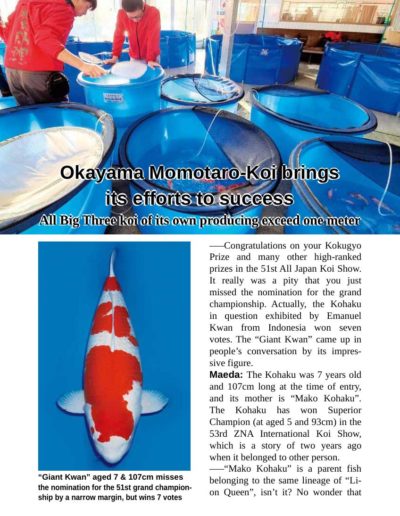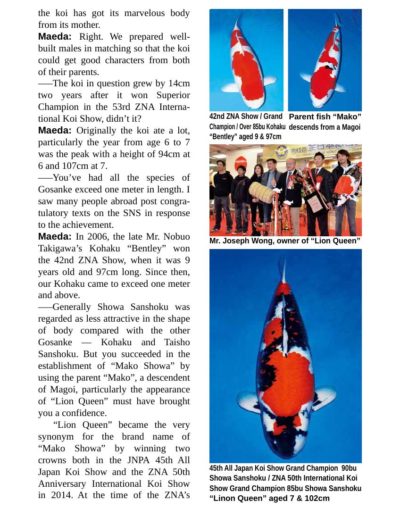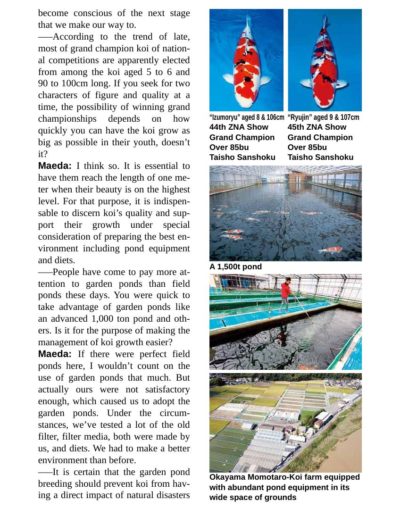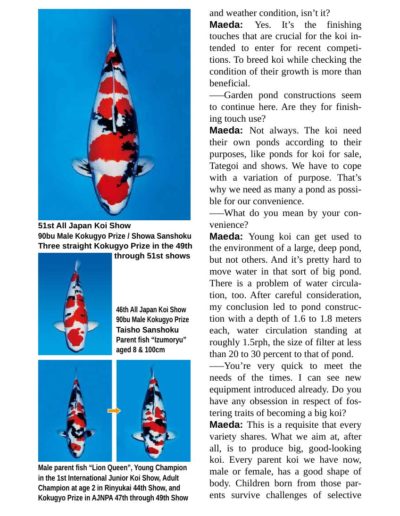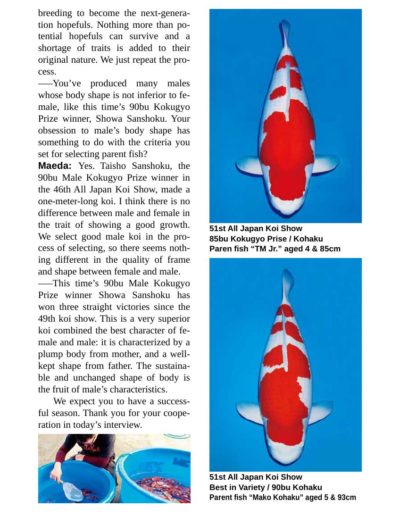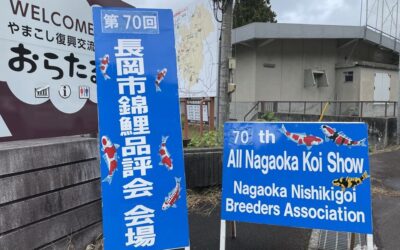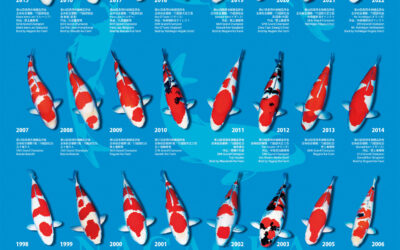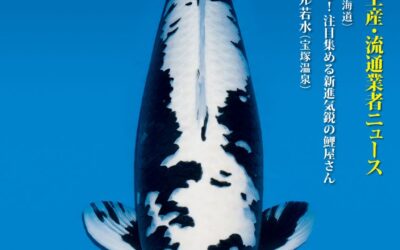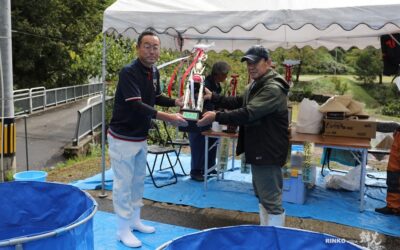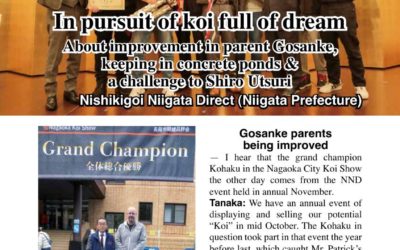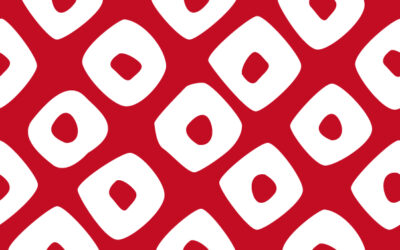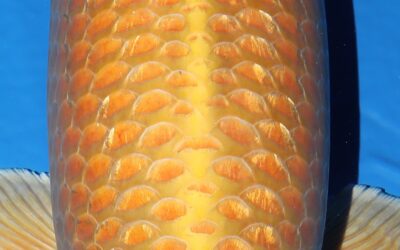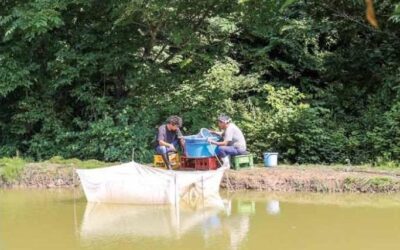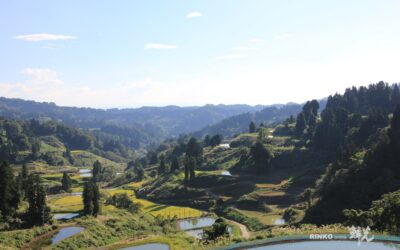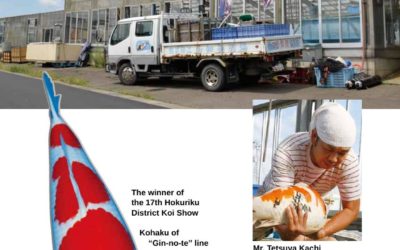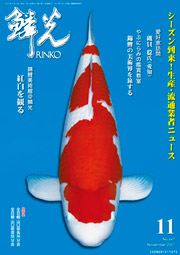Okayama Momotaro-Koi brings its efforts to success
All Gosanke koi have exceeded 1 meter!!
** This article is originally from the issue No.749 (May 2020)
—Congratulations on your Kokugyo Prize and many other high-ranked prizes in the 51st All Japan Koi Show. It really was a pity that you just missed the nomination for the grand championship. Actually, the Kohaku in question exhibited by Emanuel Kwan from Indonesia won seven votes. The “Giant Kwan” came up in people’s conversation by its impressive figure.
Maeda: The Kohaku was 7 years old and 107cm long at the time of entry, and its mother is “Mako Kohaku”. The Kohaku has won Superior Champion (at aged 5 and 93cm) in the 53rd ZNA International Koi Show, which is a story of two years ago when it belonged to other person.
—“Mako Kohaku” is a parent fish belonging to the same lineage of “Lion Queen”, isn’t it? No wonder that the koi has got its marvelous body from its mother.
Maeda: Right. We prepared well-built males in matching so that the koi could get good characters from both of their parents.
—The koi in question grew by 14cm two years after it won Superior Champion in the 53rd ZNA International Koi Show, didn’t it?
Maeda: Originally the koi ate a lot, particularly the year from age 6 to 7 was the peak with a height of 94cm at 6 and 107cm at 7.
—You’ve had all the species of Gosanke exceed one meter in length. I saw many people abroad post congratulatory texts on the SNS in response to the achievement.
Maeda: In 2006, the late Mr. Nobuo Takigawa’s Kohaku “Bentley” won the 42nd ZNA Show, when it was 9 years old and 97cm long. Since then, our Kohaku came to exceed one meter and above.
—Generally Showa Sanshoku was regarded as less attractive in the shape of body compared with the other Gosanke ― Kohaku and Taisho Sanshoku. But you succeeded in the establishment of “Mako Showa” by using the parent “Mako”, a descendent of Magoi, particularly the appearance of “Lion Queen” must have brought you a confidence.
“Lion Queen” became the very synonym for the brand name of “Mako Showa” by winning two crowns both in the JNPA 45th All Japan Koi Show and the ZNA 50th Anniversary International Koi Show in 2014. At the time of the ZNA’s event, it was 7 years old and 102cm long. Who wouldn’t say that the koi is an ideal jumbo koi combined body and quality?
Maeda: Thank you. It was a long-cherished wish for all the staff to make jumbo koi combined body shape and quality. “Lion Queen” is a very impressive koi that has realized our dream in this regard.
—At auction intended for dealers Lion Queen’s children drew people’s attention, and at the “Yume-ten” his sisters born from the same mother ― “Red Tiger” (aged 5 and 90cm) and “Aigeiou” (aged 6 and 100cm) were the objects of concern among farmers.
Maeda: At that time I got a strong response from a certain difference in body shape and quality made between the old Showa Sanshoku and new ones.
—All of your Gosanke reached almost a height of 110cm as of the 51st koi show: “Giant Kwan” Kohaku was 107cm, “Ryujin” Taisho Sanshoku of 107cm and “Aigeiou” Showa Sanshoku of 108cm, the longest. Any of them were very close to a height of 110cm. There is an atmosphere of the jumbo koi level making a further step forward.
Maeda: We are working hard to produce big and well-built koi. We believe that they should be high in an appreciation value. Not until they reach 110cm nor they have youthful characteristics like the adult and mature that their value are recognized. I wish I could realize my aim of making all Gosanke as big as 110cm and above. If it should happen, we might become conscious of the next stage that we make our way to.
—According to the trend of late, most of grand champion koi of national competitions are apparently elected from among the koi aged 5 to 6 and 90 to 100cm long. If you seek for two characters of figure and quality at a time, the possibility of winning grand championships depends on how quickly you can have the koi grow as big as possible in their youth, doesn’t it?
Maeda: I think so. It is essential to have them reach the length of one meter when their beauty is on the highest level. For that purpose, it is indispensable to discern koi’s quality and support their growth under special consideration of preparing the best environment including pond equipment and diets.
—People have come to pay more attention to garden ponds than field ponds these days. You were quick to take advantage of garden ponds like an advanced 1,000 ton pond and others. Is it for the purpose of making the management of koi growth easier?
Maeda: If there were perfect field ponds here, I wouldn’t count on the use of garden ponds that much. But actually ours were not satisfactory enough, which caused us to adopt the garden ponds. Under the circumstances, we’ve tested a lot of the old filter, filter media, both were made by us, and diets. We had to make a better environment than before.
—It is certain that the garden pond breeding should prevent koi from having a direct impact of natural disasters and weather condition, isn’t it?
Maeda: Yes. It’s the finishing touches that are crucial for the koi intended to enter for recent competitions. To breed koi while checking the condition of their growth is more than beneficial.
—Garden pond constructions seem to continue here. Are they for finishing touch use?
Maeda: Not always. The koi need their own ponds according to their purposes, like ponds for koi for sale, Tategoi and shows. We have to cope with a variation of purpose. That’s why we need as many a pond as possible for our convenience.
—What do you mean by your convenience?
Maeda: Young koi can get used to the environment of a large, deep pond, but not others. And it’s pretty hard to move water in that sort of big pond. There is a problem of water circulation, too. After careful consideration, my conclusion led to pond construction with a depth of 1.6 to 1.8 meters each, water circulation standing at roughly 1.5rph, the size of filter at less than 20 to 30 percent to that of pond.
—You’re very quick to meet the needs of the times. I can see new equipment introduced already. Do you have any obsession in respect of fostering traits of becoming a big koi?
Maeda: This is a requisite that every variety shares. What we aim at, after all, is to produce big, good-looking koi. Every parent koi we have now, male or female, has a good shape of body. Children born from those parents survive challenges of selective breeding to become the next-generation hopefuls. Nothing more than potential hopefuls can survive and a shortage of traits is added to their original nature. We just repeat the process.
—You’ve produced many males whose body shape is not inferior to female, like this time’s 90bu Kokugyo Prize winner, Showa Sanshoku. Your obsession to male’s body shape has something to do with the criteria you set for selecting parent fish?
Maeda: Yes. Taisho Sanshoku, the 90bu Male Kokugyo Prize winner in the 46th All Japan Koi Show, made a one-meter-long koi. I think there is no difference between male and female in the trait of showing a good growth. We select good male koi in the process of selecting, so there seems nothing different in the quality of frame and shape between female and male.
—This time’s 90bu Male Kokugyo Prize winner Showa Sanshoku has won three straight victories since the 49th koi show. This is a very superior koi combined the best character of female and male: it is characterized by a plump body from mother, and a well-kept shape from father. The sustainable and unchanged shape of body is the fruit of male’s characteristics.
We expect you to have a successful season. Thank you for your cooperation in today’s interview.
Enjoy our collection of articles on Japanese koi news, updates, winners, educational articles, definitions and more!
Join as a free RINKO Member for increased access and subscribe as a paid member for full access to our content.
70th Nagaoka City Koi Show Recap
by RINKO online | Oct 31, 2023
70th Nagaoka City Koi ShowThe 70th Nagaoka City Koi Show was held at Yamakoshi...
The 70th Nagaoka City Koi Show scheduled on October 29
by RINKO online | Oct 24, 2023
The 70th Nagaoka City Koi Show scheduled on October 29 ** This article is...
42nd Uonuma Koi Show
by RINKO online | Oct 23, 2023
The 42nd Uonuma City Koi Show was held at JA Kita Uonuma on 21st Oct.Murata...
Japanese RINKO 2023 November issue adverts
by RINKO online | Oct 17, 2023
Japanese RINKO 2023 November issue adverts 鱗光 2023年11月号掲載広告
Yomogihira Young Koi Show 2023
by RINKO online | Oct 12, 2023
Yomogihira Young Koi Show was held on 7th Oct. Koi Season has started! Marusho...
In pursuit of koi full of dream — Nishikigoi Niigata Direct
by RINKO online | Oct 10, 2023
In pursuit of koi full of dream About improvement in parent Gosanke, keeping...
Kanoko moyo 鹿の子模様
by RINKO online | Oct 4, 2023
Kanoko moyo 鹿の子模様 Kanoko moyo means a dappled pattern (traditional Japanese...
Fukurin 覆輪
by RINKO online | Sep 28, 2023
Fukurin 覆輪 Originally fukurin is the term to describe a decoration of gilt...
Japanese RINKO 2023 October issue adverts
by RINKO online | Sep 20, 2023
Japanese RINKO 2023 October issue adverts 鱗光 2023年10月号掲載広告
Interview with Takatatsu Koi Farm
by RINKO online | Sep 19, 2023
The 15th Nagaoka Tosai Koi Show was held at Yamakoshi Branch Office on 2nd September.
by RINKO online | Sep 6, 2023
The 15th Nagaoka Tosai Koi Show was held at Yamakoshi Branch Office on 2nd...
Kachi Koi Farm preserves its sustained individuality
by RINKO online | Aug 31, 2023
Kachi Koi Farm preserves its sustained individuality ** This article is...
RINKO Koi Magazine is NOW available online!
Blog Categories
Reminder: You must login or register for website to vote in our polls.

